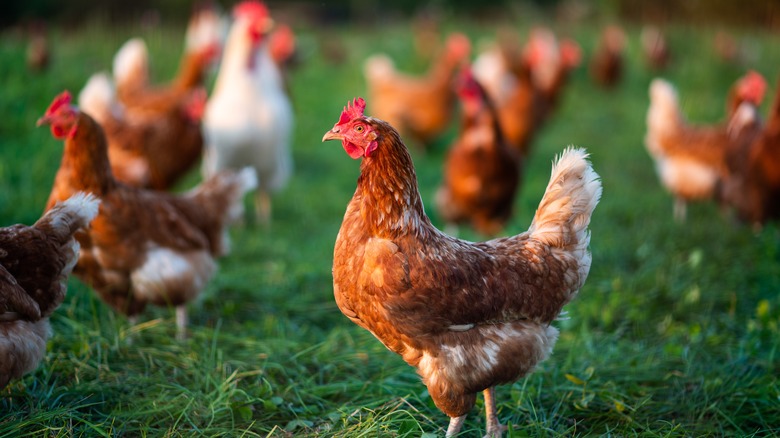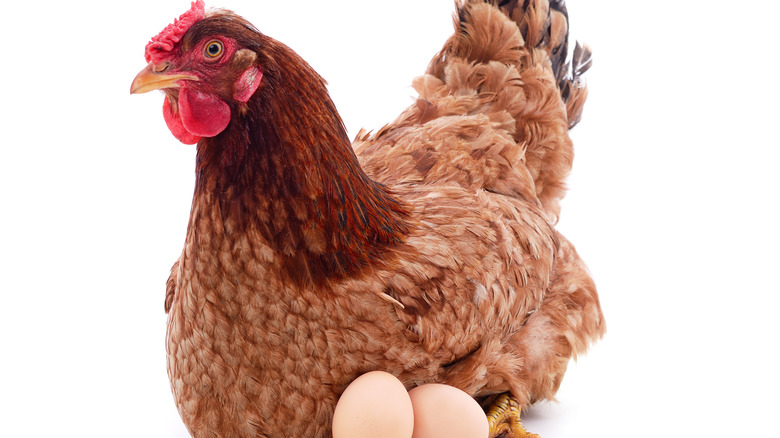The No. 1 Region In The US You'll Find More Brown Eggs Than Anywhere Else
What's the difference between white and brown eggs? Less than you might think. Basically, it's just that: color. Flavor and nutrition don't change. Why the difference at all then? The color of the chicken that lays the egg determines its shell color. White-feathered chickens lay white eggs and brown chickens lay brown ones. In this case, the chicken really does come before the egg!
Technically, it's not as strictly binary as that. Other chicken egg colors do exist. Breeds such as the Lushi, Dongxiang, and Cream Legbar lay bluish eggs, while others like the Ameraucana lay jade green eggs or even speckled olive ones (when they're crossbred with brown chickens like the Welsummer). As for white eggs, breeds such as the White Leghorn lay those.
This mostly boils down to gene-dependent pigments. Occasionally, chickens with varied heritages can lay eggs in a color that doesn't match their feathers. Other factors like age, diet, and stress may similarly alter the shade of a shell, though not the base color itself. In the United States, however, most regions are well stocked with white eggs due to the widespread populations of white chickens. How did this multicolored variation come about, though?
All chicken breeds likely originate from one region
Scientists believe the natural history of our modern, domesticated chicken began in the forests of Southeast Asia. There, one species of bird known as the red junglefowl gradually evolved with the help of a couple of other birds, such as the gray junglefowl with its yellowish skin. Somehow, the resulting crossbreed ended up in northeast China. From there, over time, it was discovered that these largely flightless chickens were good for producing meat and laying eggs, and so, animal husbandry of chickens spread farther and farther across the Old World.
It might seem logical to assume Europeans were responsible for initially bringing chickens to the New World. However, there's evidence to suggest Polynesians originally brought these birds to the Americas via the Pacific Ocean. Either way, the U.S. eventually took shape, and chicken gradually became an ever more prominent aspect of American cuisine.
For a long time, the American chicken industry was small and local. However, increasing industrialization has since transformed it into big business. Chickens went from being occasional household egg layers to full-time food factories, and this was specifically true near the East Coast to start — as evidenced by "New-York dressed" style chicken. This was largely because that region's environment suited chickens particularly well. Nowadays, chickens are found all over the country, and there are chicken recipes for lunch, dinner, and everything in between. Still, the Northeast remains a special region for chickens, especially if you're looking for brown eggs.
New England is America's brown egg capital
"Brown eggs are local eggs, and local eggs are fresh" is one of those things only people from New England say. But why? That phrase itself was created by the New England Brown Egg Council, but there's a bit more history behind its sentiment.
Regardless of how chickens in general were first brought to the Americas, it was Yankee merchants who imported mainly brown-feathered chickens to New England from China during the 1700s. The rest is history, and we now have brown American chicken breeds like the Barred Plymouth Rock, Rhode Island Red, and Silver Cross.
Brown chickens are often larger than white ones and used to be less productive, which made them more expensive to raise. So, New England chicken farmers promoted the color brown as a sign of homegrown quality, and the residents of the Northeastern U.S. often bought into that idea. For a time, many New Englanders viewed white eggs as Easter eggs only, even rejecting white-egg foods from national chains such as McDonald's.
The evolution of junglefowl to chicken and further still into variously colored breeds was a complex process. One way or another, though, we can trace that journey from Asia to the Northeast U.S., particularly when it comes to brown chickens and their eggs. There isn't really much that sets brown eggs apart in a culinary sense, but as far as their aesthetics and history go, there's certainly enough to make New Englanders adore them.


